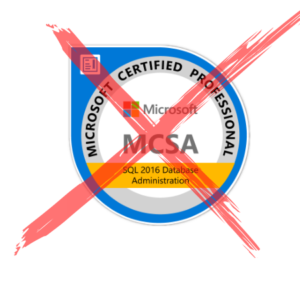Become an Expert in the Cloud with Microsoft
Learn how to build the right skills on Azure not only to enhance your digital transformation, but also to identify the right certifications to meet the tasks you have at hand, or those that you anticipate undertaking in the future.
The Digital Transformation Embraced with Azure
In the current era of digital transformation, there is no one-size-fits-all solution. If you think about it as a journey – with incremental steps toward a long-term goal – it becomes much less intimidating. Digital transformation has brought significant benefits to organizations, including:
- Increased agility
- Products getting to market faster
- Improved efficiencies
- Lower costs
Microsoft Azure enables anyone—regardless of their background or company—to accomplish more and innovate more meaningfully. The challenge is to embrace new capabilities now and to invest in those yet to come. 
How can Azure Certifications help you
If you haven’t looked at Azure in a while, you might be surprised to see what is available. Currently Azure offers more than 200 products and services to be utilized by organizations and individuals alike. An alarming statistic shows that 60% of IT decision-makers believe skills gaps cost their employees between three and eight hours per week. Imagine a whole day lost to every employee every week because they haven’t been trained in the skills they need
Azure certifications enable IT pros, developers, and data & AI professionals to validate that they have the necessary skills to cover all the aspects of your digital transformation—from managing on-premises, hybrid, or cloud infrastructure, to innovating with the best-in class applications. Reports show that role-based certifications improve IT professionals’ performance by 26% compared to their uncertified colleagues. This means they can help you ensure that your organization has the right talent.
Types of Certifications
The following certifications validate the skills that IT professionals need to develop, deploy, and manage on-premises, hybrid, or cloud infrastructure solutions. While the certificates we show here are geared towards IT professionals, you’ll see that several of them are nonetheless appropriate for other technical skillsets.
Fundamental Level
AI-900: Microsoft Azure AI Fundamentals: The Azure AI Fundamentals course is designed for anyone interested in learning about the types of solution artificial intelligence (AI) makes possible, and the services on Microsoft Azure that you can use to create them. You don’t need to have any experience of using Microsoft Azure before taking this course, but a basic level of familiarity with computer technology and the Internet is assumed. Some of the concepts covered in the course require a basic understanding of mathematics, such as the ability to interpret charts.
AZ-900: Microsoft Certified Azure Fundamentals: This course is suitable for IT personnel who are just beginning to work with Azure. This audience wants to learn about our offerings and get hands-on experience with the product. This course primarily uses the Azure portal to create services and does not require scripting skills. Students in this course will gain confidence to take other role-based courses and certifications, such as Azure Administrator.
DP-900: Microsoft Azure Data Fundamentals: The audience for this course is individuals who want to learn the fundamentals of database concepts in a cloud environment, get basic skilling in cloud data services, and build their foundational knowledge of cloud data services within Microsoft Azure.
For IT pros
Azure Administrator: This certification is recommended for cloud administrators. This is a solid starting point for all IT pros, as all other certifications assume you have strong Azure administration knowledge and experience. Azure Administrators implement, manage, and monitors identity, governance, storage, compute, and virtual networks in a cloud environment. AZ-104: Microsoft Azure Administrator
Azure for SAP workloads: This course is for Azure Administrators who migrate and manage SAP solutions on Azure. Azure Administrators manage the cloud services that span storage, networking, and compute cloud capabilities, with a deep understanding of each service across the full IT lifecycle. They take end-user requests for new cloud applications and make recommendations on services to use for optimal performance and scale, as well as provision, size, monitor and adjust as appropriate. AZ-120: Planning and Administering Microsoft Azure for SAP Workloads
Administrator for Azure Virtual Desktop: As a Windows Virtual Desktop administrator, you will work closely with the Azure Administrators and Architects, along with Microsoft 365 Administrators. Windows Virtual Desktop administrator responsibilities include planning, deploying, packaging, updating, and maintaining the Azure Windows Virtual Desktop infrastructure. AZ-140: Configuring and operating Windows Virtual Desktop on Microsoft Azure
 Azure Solutions Architect: This course is for IT Professionals with expertise in designing and implementing solutions running on Microsoft Azure. They should have broad knowledge of IT operations, including networking, virtualization, identity, security, business continuity, disaster recovery, data platform, budgeting, and governance. Azure Solutions Architect Expert (AZ-303 & AZ-304)
Azure Solutions Architect: This course is for IT Professionals with expertise in designing and implementing solutions running on Microsoft Azure. They should have broad knowledge of IT operations, including networking, virtualization, identity, security, business continuity, disaster recovery, data platform, budgeting, and governance. Azure Solutions Architect Expert (AZ-303 & AZ-304)
DevOps Engineer: Students in this course are interested in designing and implementing DevOps processes or in passing the Microsoft Azure DevOps Solutions certification exam. AZ-400: Designing and Implementing Microsoft DevOps solutions
Azure Security Engineer: All Azure certifications include a security component, but Azure Security Engineer Associate is a deep dive into security controls and threat protection. It’s all about identity and access, security across data, applications, hybrid and cloud networks, and end-to-end infrastructure. This certification is a nice complement to the Azure Administrator Associate certification. AZ-500: Microsoft Azure Security Technologies
Azure Stack Hub operator: Students for AZ-600: Configuring and Operating a Hybrid Cloud with Microsoft Azure Stack Hub are interested in becoming Azure Stack Hub operators who provide cloud services to end users or customers from within their own datacenter using Azure Stack Hub. AZ-600: Configuring and Operating a Hybrid Cloud with Microsoft Azure Stack Hub
For Developers
Azure Developer: Developers will learn how to create end-to-end solutions in Microsoft Azure. Students will learn how to implement Azure compute solutions, create Azure Functions, implement and manage web apps, develop solutions utilizing Azure storage, implement authentication and authorization, and secure their solutions by using KeyVault and Managed Identities. AZ-204: Developing Solutions for Microsoft Azure
Azure AI Engineer: Software engineers concerned with building, managing and deploying AI solutions that leverage Azure Cognitive Services, Azure Cognitive Search, and Microsoft Bot Framework. They are familiar with C# or Python and have knowledge on using REST-based APIs to build computer vision, language analysis, knowledge mining, intelligent search, and conversational AI solutions on Azure. AI-102: Designing and Implementing a Microsoft Azure AI Solution
Azure IoT developer: The Azure IoT Developer is responsible for the implementation and the coding required to create and maintain the cloud and edge portion of an IoT solution. In addition to configuring and maintaining devices by using Azure IoT services and other Microsoft tools, the IoT Developer also sets up the physical devices and is responsible for maintaining the devices throughout the life cycle. The IoT Developer implements designs for IoT solutions, including device topology, connectivity, debugging and security. For Edge device scenarios, the IoT Developer also deploys compute/containers and configures device networking, which could include various edge gateway implementations. AZ-220: Microsoft Azure IoT Developer
Azure Solutions Architect: Azure Solutions Architect Expert (AZ-303 & AZ-304) (see above)
DevOps Engineer: AZ-400: Designing and Implementing Microsoft DevOps solutions (see above)
For Data & AI pros
Azure AI Engineer: AI-102: Designing and Implementing a Microsoft Azure AI Solution (see above)
Data Analyst: The audience for this course are data professionals and business intelligence professionals who want to learn how to accurately perform data analysis using Power BI. This course is also targeted toward those individuals who develop reports that visualize data from the data platform technologies that exist on both in the cloud and on-premises. DA-100: Analyzing Data with Power BI
Azure Data Scientist: This course is designed for data scientists with existing knowledge of Python and machine learning frameworks like Scikit-Learn, PyTorch, and Tensorflow, who want to build and operate machine learning solutions in the cloud. DP-100: Designing and Implementing a Data Science Solution on Azure
Azure Data Engineer: The primary audience for this course is data professionals, data architects, and business intelligence professionals who want to learn about data engineering and building analytical solutions using data platform technologies that exist on Microsoft Azure. DP-203: Data Engineering on Microsoft Azure
Azure Database Administrator: The audience for this course is data professionals managing data and databases who want to learn about administering the data platform technologies that are available on Microsoft Azure. This course is also valuable for data architects and application developers who need to understand what technologies are available for the data platform with Azure and how to work with those technologies through applications. DP-300: Administering Relational Databases on Microsoft Azure

Become Certified Today
In today’s cloud-based digital world, we’re dedicated to helping you and your team develop the skills you need. Learn how you can become certified in today’s hottest Azure technologies by contacting us.


















